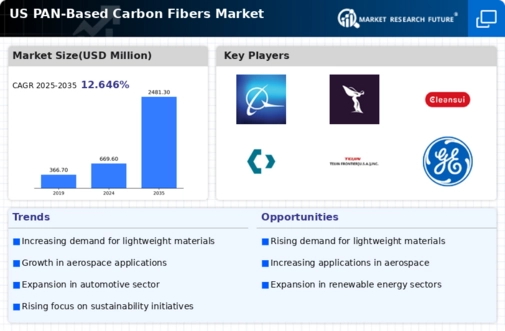The pan based-carbon-fibers market is currently characterized by a dynamic competitive landscape, driven by increasing demand across various sectors such as aerospace, automotive, and construction. Key players are actively pursuing strategies that emphasize innovation, sustainability, and regional expansion. For instance, Toray Industries (Japan) has positioned itself as a leader through continuous investment in R&D, focusing on high-performance materials that cater to the evolving needs of its clients. Similarly, Hexcel Corporation (US) has been enhancing its operational capabilities by integrating advanced manufacturing technologies, which not only improve efficiency but also reduce environmental impact. These strategic initiatives collectively contribute to a competitive environment that is increasingly focused on technological advancement and sustainability.
In terms of business tactics, companies are localizing manufacturing to better serve regional markets and optimize supply chains. This approach appears to be particularly effective in a moderately fragmented market structure, where the collective influence of key players shapes pricing strategies and product availability. The emphasis on supply chain optimization is evident as firms seek to mitigate risks and enhance responsiveness to market demands, thereby fostering a more resilient operational framework.
In October 2025, Mitsubishi Chemical Corporation (Japan) announced a strategic partnership with a leading aerospace manufacturer to develop next-generation carbon fiber composites. This collaboration is expected to leverage both companies' strengths in material science and aerospace engineering, potentially leading to innovative solutions that meet stringent industry standards. The strategic importance of this partnership lies in its potential to enhance product offerings and expand market reach, particularly in the aerospace sector, which is increasingly prioritizing lightweight materials for fuel efficiency.
In September 2025, SGL Carbon (Germany) unveiled a new production facility in the US aimed at increasing its output of carbon fibers for the automotive industry. This facility is expected to utilize state-of-the-art technology to enhance production efficiency and reduce costs. The establishment of this facility signifies SGL Carbon's commitment to meeting the growing demand for lightweight materials in the automotive sector, which is crucial for manufacturers aiming to comply with stringent emissions regulations.
In August 2025, Zoltek Companies (US) launched a new line of sustainable carbon fibers derived from renewable sources. This initiative aligns with the increasing market demand for environmentally friendly materials and positions Zoltek as a forward-thinking player in the industry. The strategic importance of this launch is underscored by the growing consumer preference for sustainable products, which could enhance Zoltek's competitive edge in a market that is progressively leaning towards sustainability.
As of November 2025, the competitive trends in the pan based-carbon-fibers market are increasingly defined by digitalization, sustainability, and the integration of AI technologies. Strategic alliances are becoming more prevalent, as companies recognize the value of collaboration in driving innovation and enhancing market presence. Looking ahead, it is likely that competitive differentiation will evolve, shifting from traditional price-based competition to a focus on innovation, technological advancements, and supply chain reliability. This transition suggests that companies that prioritize these aspects will be better positioned to thrive in an increasingly competitive landscape.


















Leave a Comment